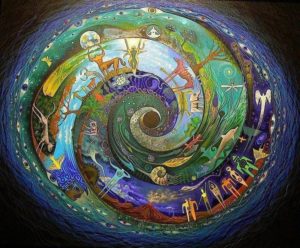As We Glory In New Birth, We Also Face Up To What Is Dying: What Do We Value?
 I so want to think and write about new birth right now. We’ve just gone through that most glorious season of celebrating it in all its possible meanings. I’m fired up to start anew in envisioning a mesmerizing version of Church, embracing all genders in leadership, in ministry, in priesthood. I want to dream about what that looks like, acts like, means for us as individuals, as world citizens, as sacred vessels.
I so want to think and write about new birth right now. We’ve just gone through that most glorious season of celebrating it in all its possible meanings. I’m fired up to start anew in envisioning a mesmerizing version of Church, embracing all genders in leadership, in ministry, in priesthood. I want to dream about what that looks like, acts like, means for us as individuals, as world citizens, as sacred vessels.
First though, in the infancy of the year, I am taken back to the old that is dying: a musty, broken, stifling, patched over and crumbling…but also majestic, beautiful, scintillating, persistent and courageous Church; a frightening… but also frightened, an insipid…but also inspiring Church, one that so many of us still love. What do we want in all of these aspects to take with us as we renew and recreate? What do we most value?
I am currently reading Paul Kalanithi’s best-selling memoir, When Breath Becomes Air. At one point, he reflects on his experience as a neurosurgeon, specifically on the times when he must, with unimaginable delicacy and care, repair areas, or remove tumors from, intricately complicated parts of people’s brains. One mistake, one slip, could change people’s lives forever, not only their mobility or thought or emotion but their very sense of self. He writes: “The call to protect life – and not merely life but another’s identity; it is perhaps not too much to say another’s soul – was obvious in its sacredness.”
With this kind of sacred mission, he dedicated himself first to know his patients fully, their mindsets, their world views, their identities, their values, what makes life precious to them and what internal destructive force would make it prudent to let their life end. Later on, as he discovered his own terminal cancer and endured its progression, he had to try to discover the same things about himself.
As I said before, I cannot wait to take the next step in envisioning and acting to bring about a new, dynamically inclusive Church for a new day, but I believe we must deal with the old one first, the preciousness of its identity that, like the neurosurgeon operating on a brain, we want to preserve. We must protect its gifts, its sacred soul; we must take the time (I know, I know, we’ve had centuries to do that!) to know it well enough to preserve and cherish what we will take with us. We must also, I think, do the same with ourselves.
I’ll make a brief, humble start. (I’m sure you who have studied and thought deeply about this aspect will have much more profound and expansive ideas.)
I want to take with me the rituals, even the medievalness of some of them, to connect me with a rich tradition of people all over the world throughout centuries saying, in different languages, the same words, performing the same rites, praying the same prayers, receiving the Eucharist, singing the psalms. I confess I love the color and drama and the continuity and connection this brings. And I love that it all makes the church experience so different from everyday life, much more than just a lecture, a series of readings and recitations, discussions and dialogues. Even more I want the social justice emphasis emphasized even more. This is the one tradition that needs to be celebrated and then expanded. Then there’s the rich community, and…well, as I mentioned this is just a start – or the start of something finishing.
The Roman god, Janus, as we know, has two faces, one looking forward, one looking back. That’s not a bad image to keep in front of us throughout the year as we keep renewing and rebuilding…albeit with one exception: Dear Janus, now you will not have just two faces of one gender, but many faces, all genders included. What amazing vision – forward and back – you will have now!

2 Responses
Beautiful meditation. We should not throw the baby out with the bathwater. Christianity is not intrinsically patriarchal, but abides in the flesh, a flesh that is still trying to overcome the curse of gender inequality (Genesis 3:16). It is not just about women. Religious patriarchy is harmful, ESPECIALLY TO THE MEN OF THE CHURCH. Now that the patriarchal era of human history is passing away, it is time to keep what is good, let go of what is bad. When we have women priests, more men will go to church. I suggest we should study the THEOLOGY OF THE BODY. It shows that, for NATURAL COMPLEMENTARITY in the hierarchy, we should have 7 sacraments for boys and 7 sacraments for girls. This is not a matter of justice for women, but a matter of justice for the entire body of Christ, male and female. Then, and only then, can the Church be an instrument of INTEGRAL HUMAN DEVELOPMENT and a beacon of social and ecological justice going forward.
Love these reflections! Thanks Ellie.